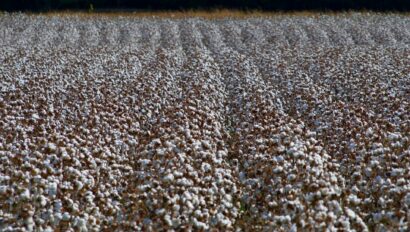Textile Exchange’s Benchmark program to cover nature impacts for the first time
Textile Exchange’s Benchmark program to cover nature impacts for the first time
Created in partnership with Conservation International and The Biodiversity Consultancy, with support from corporate partner Sappi, the Biodiversity Benchmark provides a roadmap for companies to understand their impacts on nature and to deliver positive outcomes.
Textile Exchange’s Materials Benchmark program is launching a new tool to help the fashion and textile industry take urgent action on biodiversity. The Biodiversity Benchmark, developed in partnership with The Biodiversity Consultancy, Conservation International and kindly supported by Sappi, will enable companies to understand their impacts and dependencies on nature, chart a pathway to delivering positive biodiversity outcomes, and benchmark their progress.
Against the backdrop of the Covid-19 pandemic, forest fires, and increasing evidence of continued dramatic species loss, the importance of biodiversity has never been so clear. At the beginning of 2020, the World Economic Forum’s Global Risk Report named biodiversity loss as one of the top five risks facing society.
The Materials Benchmark has tracked corporate fiber and materials sourcing practices since its launch five years ago, mobilizing the fashion and textile industry to accelerate the uptake of preferred materials such as organic cotton, recycled polyester, and preferred manmade cellulosics. The program is the largest peer-to-peer benchmarking exercise in the sector, with around 200 participating brands and retailers, including Gucci, H&M Group, Norrøna, Patagonia, Tchibo and The North Face. In 2020, the CFMB is open to suppliers and manufacturers for the first time, and over 20 leading textile companies – including Birla Cellulose, Part of the Aditya Birla Group, Lenzing, The Schneider Group, Sulochana and World Textile Sourcing (WTS) – are stepping up to take part.
“Participating companies are already making significant headway in identifying their portfolio of materials, the sustainability programs they are investing in, targets for uptake and improvement, and calculating their volumetric uptake of preferred fibers and materials in use,” said Liesl Truscott, Director of European & Materials Strategy, Textile Exchange. “The new Biodiversity Benchmark can help take them to the next stage, from decarbonizing their materials to embedding positive biodiversity outcomes in their strategies.”
The materials benchmarking inclusion of biodiversity comes as 77 political global leaders committed to reverse biodiversity loss by 2030 at the United Nations Summit on Biodiversity in September, and over one thousand companies signed up to the Business for Nature Coalition.
Textile Exchange CEO, La Rhea Pepper, commented: “As an organic cotton farmer, biodiversity is at the heart of everything for me. It provides benefits that address climate change, such as carbon sequestration, regulation of local climate air quality, and moderates extreme natural events. Additionally, biodiversity plays a key role in other benefits such as pollination, erosion prevention, waste-water treatment, biological control of pests and disease, and preventing species extinction. Our sector can do so much that is nature-positive, and I look forward to seeing the first benchmark results.”
The Biodiversity Benchmark was co-created by Textile Exchange with The Biodiversity Consultancy, technical and policy specialists in biodiversity and ecosystem services, and Conservation International, a global nonprofit working to protect nature. Generous support was also provided by biobased materials provider Sappi, as a corporate partner.
The Biodiversity Consultancy’s Chief Executive, Dr Helen Temple, said: “The fashion and textile industry now has an opportunity to establish a leadership position in how it tackles biodiversity and nature loss. Nature is in the spotlight more than ever before and understanding where and how companies impact on nature – and what they can do about it – has become increasingly important. Both in terms of operational decisions, and in the pursuit of the systemic, transformational shifts we need to drive nature-positive change.”
Conservation International’s Senior Advisor on Resilient Supply Chains, Dr Helen Crowley, commented: “The decisions we make now – as companies, individuals and as a society – will determine how we survive and if we thrive. We need to have the very best information and guidance to take the right decisions and rapid actions. Textile Exchange with this new biodiversity benchmark continues to catalyze and guide the sector towards the outcomes we all need.”
Industry Support for the Benchmark
The Biodiversity Benchmark was developed with the support of a multi-stakeholder advisory group, involving over 30 biodiversity experts, NGOs and representatives from across the fashion and textile industry.
Krelyne Andrew, Head of Sustainability at Sappi Verve, said: “In a world where natural resources are under increasing pressure, it’s our responsibility to tread more lightly on our planet and work together to protect, restore and sustainably use natural resources. Doing so, is not an event, rather an ongoing process that requires collective action and commitment. We congratulate Textile Exchange on their initiative to mainstream biodiversity action across the textile value chain. As the world’s leading supplier of dissolving pulp as well as casting and release paper into the textile value chain, we look forward to continuing our collaboration to ensure the benchmark delivers positive impacts on nature.”
Eva von Alvensleben, Executive Director of the Fashion Pact, said: “We are very excited for the launch of the Textile Exchange Biodiversity Benchmark. Not only is this a step forward for our signatories in advancing on their global commitments, but will allow for the development of a common understanding of the information needed to shape effective biodiversity strategies as an industry.”
Erin Billman, Executive Director of the Science Based Targets Network, commented: “Since the nature and climate crises are deeply intertwined, we must tackle both simultaneously. We welcome Textile Exchange’s efforts to tackle biodiversity loss and we look forward to working with them and the textile industry on science-based targets for nature. For companies, tackling nature loss alongside reducing greenhouse gas emissions is the most efficient approach to reducing both nature and climate-related risk. We need to maximize carbon sequestration as well as help stabilize nature which is the source of the food, fiber and fuel we all depend on.”
Dr. Katrina ole-MoiYoi, Sustainable Sourcing Specialist at Kering, said: “Textile Exchange’s new benchmarking tool will provide a guiding light for the industry as it embarks on the critical endeavour of integrating biodiversity into our business strategies. It will not only help take the pulse of fashion’s relationship with nature, but will also propel the type of individual and collective action needed to protect and restore our planet’s precious ecosystems. At Kering, following our ongoing work in this area, including the release of our biodiversity strategy and commitment to have a net-positive impact on biodiversity by 2025, we are delighted to support Textile Exchange in securing broad adoption of its tool, similar to how we have been supporting the science-based target for nature.”
Scott Leonard, INDIGENOUS Co-Founder, said: “The road ahead to adopt business practices that protect biodiversity is an arduous task. We need much stronger alignment with all stakeholders in the value chain surrounding industry to adequately scale the rapid adoption of next generation solutions that truly protect our environment.”
Notes
The Biodiversity Benchmark is launching in beta this year, collaboratively developed by an advisory group. The survey will be open from December 1, 2020 to January 31, 2021. All interested companies are eligible, and it is free to join. For companies participating in the Material Change Index, the signature product of the Corporate Fiber & Materials Benchmark (CFMB) program access to the survey will be via their existing company portal. New companies can register here: https://cfmb.textileexchange.org/ or contact one of the team at cfmb@textileexchange.org
Getting started:
- If you are a company, register for the Biodiversity Benchmark and join our Introduction to the Biodiversity Benchmark (webinar date to be confirmed) with Textile Exchange, The Biodiversity Consultancy and Conservation International.
- Visit the Biodiversity Benchmark website and download the Biodiversity Benchmark Guides
- Survey Guide (provides detailed support for completing the benchmark)
- Companion Guide (material-specific information to help build the bridge between a materials strategy and important biodiversity considerations).
Textile Exchange Textile Exchange is a global nonprofit that creates leaders in the sustainable fiber and materials industry. The organization develops, manages, and promotes a suite of leading industry standards as well as collects and publishes vital industry data and insights that enable brands and retailers to measure, manage, and track their use of preferred fiber and materials.
With a membership that represents leading brands, retailers, and suppliers, Textile Exchange has, for years, been positively impacting climate through accelerating the use of preferred fibers across the global textile industry and is now making it an imperative goal through its 2030 Strategy: Climate+. Under the Climate+ strategic direction, Textile Exchange will be the driving force for urgent climate action with a goal of 45% reduced CO2 emissions from textile fiber and material production by 2030.
To learn more about Textile Exchange, visit TextileExchange.org. Follow us on Twitter at @TextileExchange.
The Biodiversity Consultancy works with sector-leading clients to integrate nature into business decision-making and build sustainable pathways to positive environmental outcomes. Through our strategic, technical and policy expertise, we guide clients in the fashion and textile sector through biodiversity risk and develop project- and corporate-level biodiversity strategies, risk screening programs, value chain footprinting, and resilient management plans. Our science-based, pragmatic approach delivers robust solutions to complex biodiversity challenges such as achieving Net Gain for biodiversity, creating science-based targets for nature, developing biodiversity offsets, metrics and indicators, and discovering opportunities to go Nature Positive.
Conservation International works to spotlight and secure the critical benefits that nature provides to humanity. Building upon a strong foundation of science, partnership and field demonstration, Conservation International’s mission is to empower societies to responsibly and sustainably care for nature, our global biodiversity, for the well-being of humanity.

